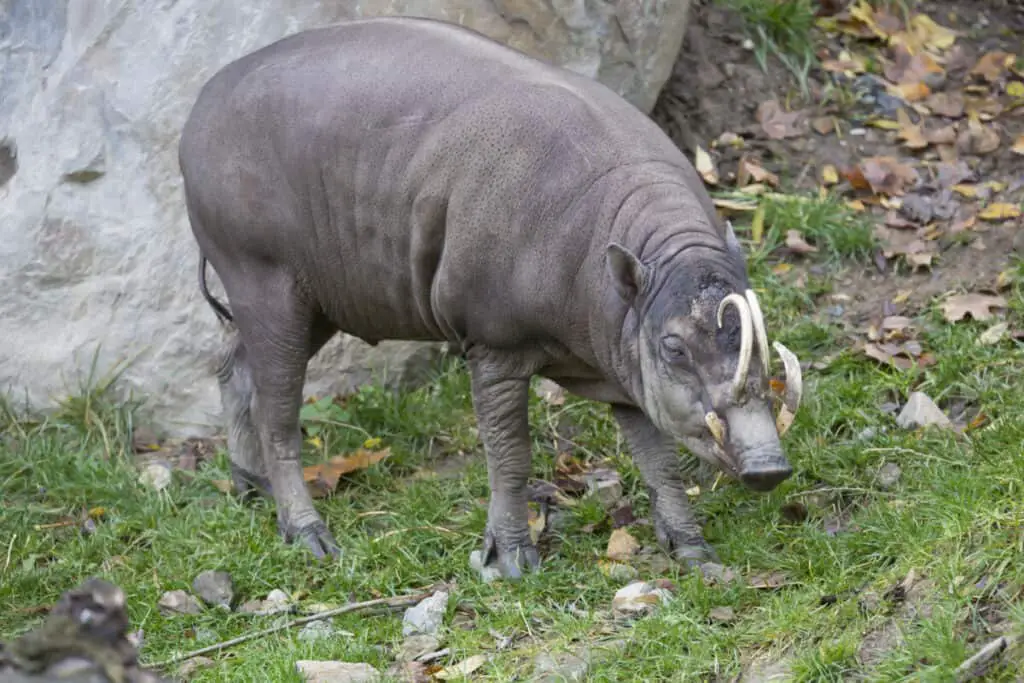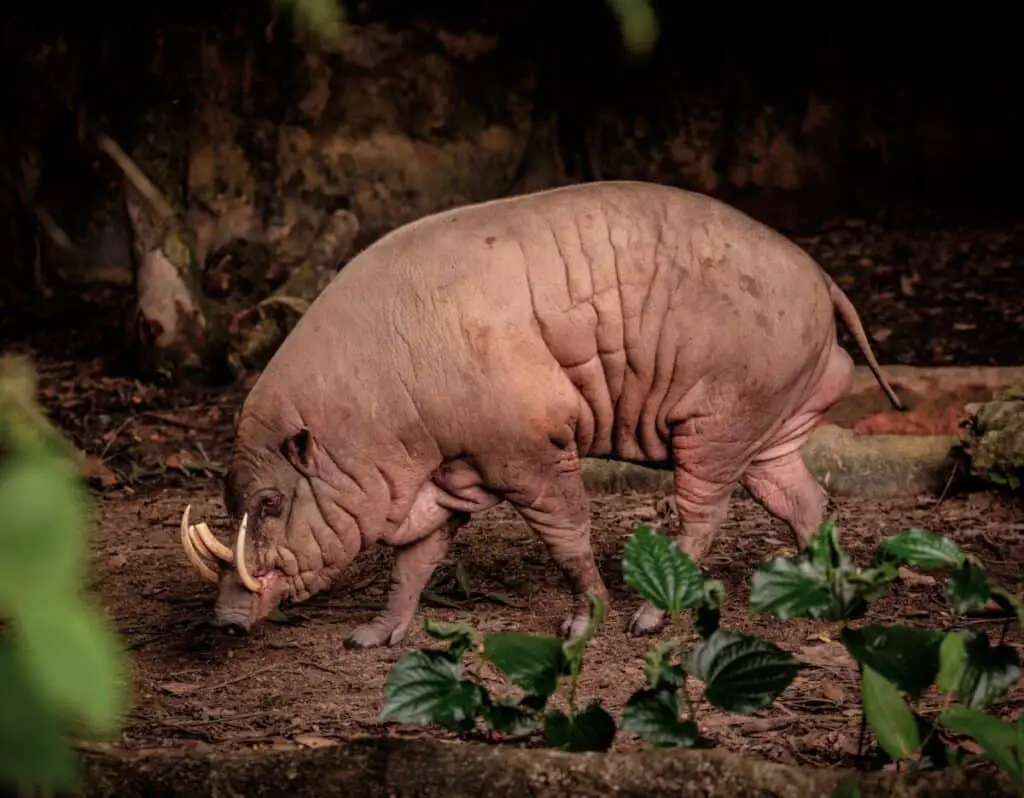Babirusa, also known as the deer-pig or pig-deer, is a unique and fascinating animal found in the forests of Indonesia.
Babirusas are members of the Suidae family which includes domesticated pigs and wild boars. However, unlike their relatives, babirusas have several distinctive features such as elongated canine teeth that curve upwards through the roof of their mouth and tufted ears.
These animals are relatively small, with an average weight of 100-120 kg for males and 50-80 kg for females. Their coat color ranges from gray to brownish-black with white markings on their legs, snout, and tail.
Despite being hunted by humans for their meat and tusks, babirusas have managed to survive over centuries due to their elusive nature and remote habitats.
In this article, we will explore the unique characteristics of babirusas including their physical traits, behavior patterns, habitat requirements, population status, and conservation efforts undertaken to protect them from extinction.

Physical Characteristics
Babirusa, also known as deer-pigs or pig-deer, are a species of wild pig found in the Indonesian islands of Sulawesi, Togian, Sula and Buru.
They have an unusual appearance with its curved tusks that emerge from their snouts and curve back toward their foreheads.
Dietary habits play a vital role in babirusa’s evolutionary adaptations.
These pigs feed on fruits, nuts, seeds and roots during the wet season while they eat worms, insects and small animals during the dry season when sources of plant food become scarce.
Babirusas’ long legs allow them to travel great distances in search for food which is essential for survival in harsh environments where resources are limited.
Additionally, these omnivores have adapted to digest tough vegetation by developing longer digestive tracts compared to other mammals of similar size.
Behavioral Patterns
In terms of social interactions, babirusas are generally solitary animals, only coming together during mating season. During this time, males will fight for the right to mate with females. These fights can be violent and often result in injuries. Once a male has won the right to mate with a female, he will stay close to her until she gives birth.
Communication methods among babirusas include vocalizations such as grunts and squeals, as well as various body language cues like ear position and tail movement. They also use scent marking to communicate their presence and territory to other babirusas.
Despite their solitary nature, they do have some limited forms of social behavior such as grooming each other or sharing resources when necessary.
Habitat Requirements
Babirusa are known to inhabit a variety of different habitats throughout their range. The distribution of babirusa includes the islands of Sulawesi, Togian, Sula, Buru, and Bacan in Indonesia.
They can be found in primary and secondary forests as well as mangrove swamps and grasslands. However, they tend to prefer areas with dense vegetation cover such as rainforests where they can forage for food undisturbed.
Their ecological niche is that of an omnivorous animal which feeds on plants, fruits, insects, and small animals like rodents or birds. Babirusa have a unique adaptation called tusks which grow upward through their snouts instead of downwards like other wild pigs.
This adaptation allows them to reach roots and tubers buried deep beneath the ground surface which other herbivores cannot access easily. Despite being able to thrive in various types of environments, habitat destruction due to human activities has caused a decline in their populations over recent years.
Population Status
The babirusa, a unique pig species found in the Indonesian islands of Sulawesi and Buru, is currently listed as vulnerable by the International Union for Conservation of Nature (IUCN).
The primary threats to this species include habitat loss due to deforestation, hunting for meat and ivory tusks, and competition with domestic pigs. Additionally, climate change may pose a threat to their habitats in the future.
Despite conservation efforts such as protected areas and captive breeding programs, current trends show that population numbers continue to decline.
However, there are some future prospects for the babirusa’s population status. Education campaigns aimed at reducing illegal hunting practices have been successful in certain areas. Furthermore, ecotourism has emerged as a potential income source for local communities who can benefit from protecting babirusas and their habitats.
Further research on these topics could lead to better-informed conservation strategies that could help stabilize or even increase babirusa populations in the wild.
Threats To Their Survival
Despite being widely distributed in Indonesia, the babirusa population is considered to be threatened. The International Union for Conservation of Nature (IUCN) has classified this species as vulnerable due to its declining numbers and habitat loss. In Sulawesi, where most babirusas are found, hunting pressure remains a significant threat to their survival.
To address the issue of poaching, various conservation organizations have implemented measures such as public awareness campaigns and community-based patrolling systems. These actions aim to reduce illegal hunting activities by increasing people’s knowledge about the importance of protecting these animals while providing alternative livelihoods for those who rely on poaching as a source of income.
Additionally, efforts have been made to protect babirusa habitats from further fragmentation through land-use planning and forest protection programs. Nevertheless, more action needs to be taken at both local and national levels to ensure that these efforts lead to substantial improvements in the status of this unique animal species.
Habitat fragmentation poses another major challenge to the survival of babirusas. This phenomenon results from human activities such as logging, agricultural expansion, and infrastructure development which contribute significantly to deforestation in Southeast Asia. As a result, isolated patches of forests remain scattered across landscapes with limited connectivity between them.
For babirusas that require vast areas of tropical rainforests for their survival and reproduction, habitat fragmentation can limit access to food sources and mates leading ultimately reducing their chances for long-term persistence.
Therefore it is necessary for policymakers and stakeholders involved in land-use decision-making processes to consider incorporating biodiversity concerns into spatial planning strategies such as zoning laws or protected area designations aimed at mitigating habitat loss or degradation caused by fragmented landscapes without compromising socio-economic development goals in rural communities living adjacent to these ecosystems.
The Babirusa’s Predators Revealed: Unmasking the Threats

Conservation Efforts
Collaborative initiatives have been implemented to conserve the babirusa population. The Indonesian government, in partnership with various conservation organizations such as WWF and Conservation International, has established protected areas for these animals. These efforts aim to preserve their natural habitat and prevent illegal hunting practices.
Moreover, eco tourism opportunities have also been created to promote awareness and generate revenue that can be used for further conservation efforts. Tourists are offered guided tours of the babirusas’ habitat, where they can observe these unique creatures in their natural environment. Eco lodges have also been built near these protected areas, providing visitors with a sustainable way to experience Indonesia’s rich biodiversity.
Visitors who witness the majesty of these rare animals firsthand often describe it as a life-changing experience. Seeing them thrive in their natural habitat evokes a sense of wonder and respect for nature. The realization that our actions can directly affect the survival of species like the babirusa is humbling yet empowering.
Knowing that these collaborations make it possible to protect endangered species reinforces one’s faith in humanity’s potential for positive impact. Encountering this elusive creature leaves an indelible impression on visitors, motivating them to support ongoing conservation efforts.
Through collaborative initiatives and eco-tourism opportunities, there is hope that future generations will continue to enjoy the beauty of the babirusa. By working together towards its preservation, we ensure that this magnificent animal remains a vital part of Indonesia’s natural heritage.
Conclusion
The babirusa, also known as the ‘deer-pig,’ is a unique and fascinating mammal found in Indonesia. These animals possess distinctive physical characteristics such as long tusks that curl back towards their forehead, and curly hair on their backs.
Babirusas are primarily solitary creatures, with males remaining territorial and females raising their young alone. They inhabit dense forests, swamps and other wetlands where they forage for fruits, roots and small animals.
Unfortunately, habitat destruction due to logging and farming activities has led to a decline in babirusa populations throughout their native range. Furthermore, hunting for meat and traditional medicine purposes remains a threat to these intriguing animals.
Nevertheless, conservation efforts have been put into place by local governments and organizations in order to protect the babirusa from extinction. Overall, the preservation of this species requires continued support through public awareness campaigns aimed at reducing demand for its products coupled with strict law enforcement actions against poaching.
Only then can we ensure that future generations will be able to catch a glimpse of these magnificent creatures living peacefully in their natural habitats.

